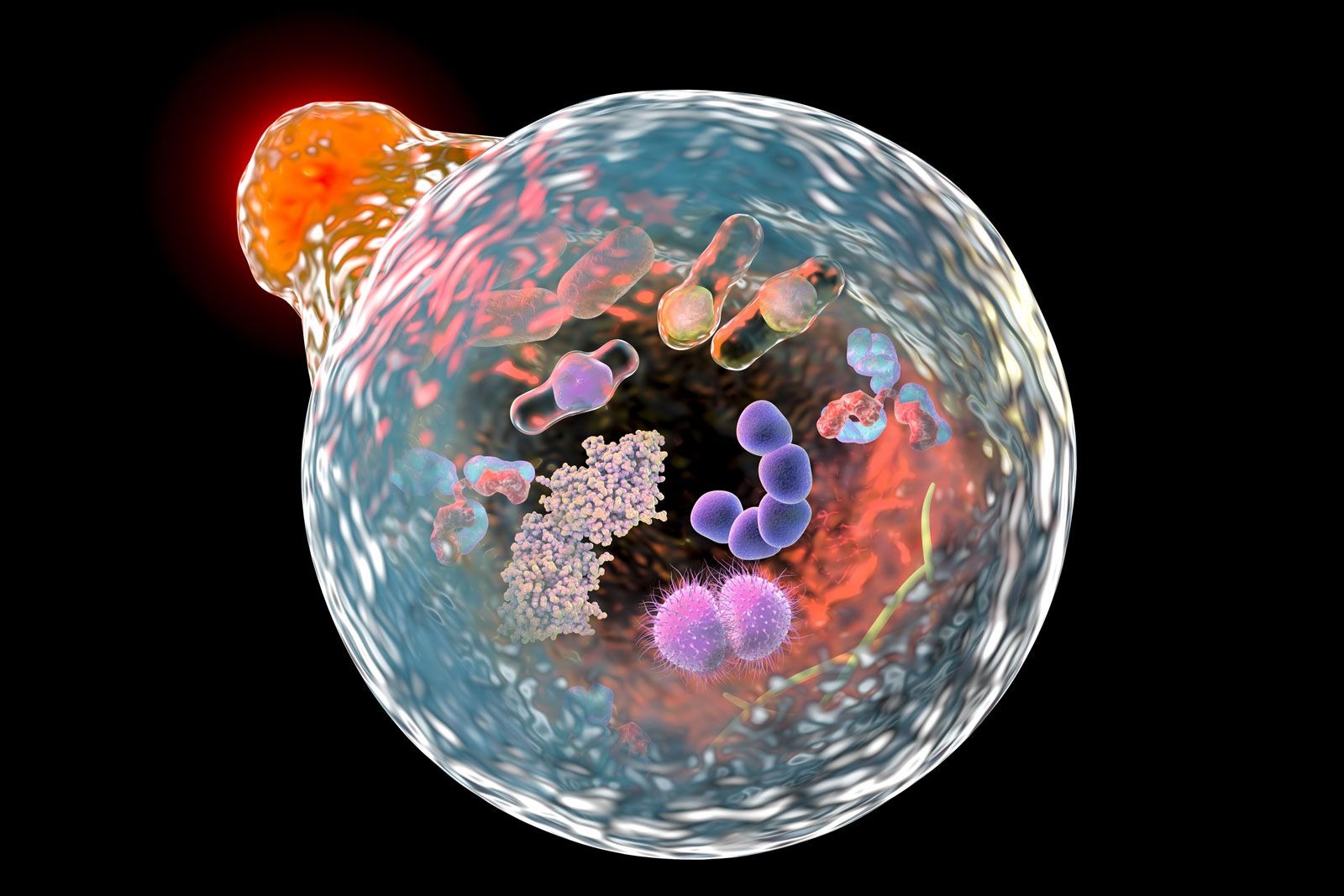Home>Misc>Featured>Why Are Lysosomes Important To The Health Of Cells?


Featured
Why Are Lysosomes Important To The Health Of Cells?
Published: September 10, 2023
Discover the significance of lysosomes in maintaining cellular health. Explore the featured role of lysosomes in vital cellular processes and their impact on overall cell function.
Introduction
Lysosomes are essential organelles found in all eukaryotic cells that play a vital role in maintaining the health and functionality of cells. These small, membrane-bound structures are often referred to as the “recycling centers” of the cell, responsible for breaking down and recycling various molecules, as well as eliminating harmful substances. Lysosomes are involved in a wide range of cellular processes, including digestion, waste disposal, and cell signaling.
Discovered by Belgian cytologist Christian de Duve in the 1950s, lysosomes have since captured the attention of scientists worldwide due to their critical functions in cell biology. These organelles contain a combination of enzymes that have the ability to break down different types of macromolecules, such as proteins, carbohydrates, nucleic acids, and lipids. This unique ability to degrade various cellular components makes lysosomes an integral part of maintaining cellular homeostasis and overall cell health.
The structure and composition of lysosomes are carefully designed to ensure their effectiveness. Typically, these organelles are small, spherical vesicles surrounded by a single membrane. The membrane acts as a barrier, keeping the powerful enzymes contained within the lysosome. The interior of the lysosome is acidic, maintained by proton pumps on the lysosomal membrane. This acidic environment is crucial for the optimal functioning of the lysosomal enzymes.
The importance of lysosomes cannot be overstated, as they have several vital functions in maintaining the health of cells. In addition to their role in intracellular digestion and recycling, lysosomes are also involved in cellular defense mechanisms, cell death regulation, and nutrient sensing. Dysfunctional lysosomes have been implicated in numerous diseases, including lysosomal storage disorders, neurodegenerative diseases, and certain forms of cancer.
Overview of Lysosomes
Lysosomes are small vesicles found in the cytoplasm of eukaryotic cells. They are considered the cell’s recycling centers and are filled with powerful enzymes that help break down and recycle various macromolecules. These enzymes are referred to as acid hydrolases and work best in an acidic environment, which is maintained by proton pumps on the lysosomal membrane.
The discovery of lysosomes revolutionized our understanding of cellular processes and garnered Christian de Duve the Nobel Prize in Physiology or Medicine in 1974. Since then, researchers have made significant advancements in uncovering the intricate functions of these organelles.
Structurally, lysosomes are small spherical vesicles enclosed by a single membrane. They vary in size, ranging from 0.1 to 1.2 micrometers in diameter. Within the lysosome, various hydrolytic enzymes are present, including proteases, lipases, nucleases, and glycosidases. These enzymes work together to break down proteins, lipids, nucleic acids, and carbohydrates into their subunits for either recycling or disposal.
In addition to their digestive functions, lysosomes play a crucial role in maintaining cellular homeostasis. They are responsible for the degradation and clearance of damaged organelles, unwanted proteins, and pathogens through a process called autophagy. This ensures the proper functioning and renewal of cellular components, safeguarding against the accumulation of damaged or potentially harmful material.
Furthermore, lysosomes are involved in the regulation of cell death, or apoptosis. They are responsible for initiating the breakdown of cellular components during programmed cell death, a necessary process for tissue development and maintenance. Lysosomes also aid in the modulation of cell signaling pathways by regulating the availability of specific extracellular molecules, such as growth factors.
Overall, lysosomes serve as essential organelles involved in numerous cellular processes, including digestion, recycling, defense mechanisms, and cell signaling. Their effective functioning is crucial for the overall health and functionality of cells.
Structure of Lysosomes
Lysosomes are organelles that have a distinct structure, allowing them to perform their crucial functions. These small vesicles are enclosed by a single membrane and contain an array of specialized enzymes.
The lysosomal membrane acts as a barrier, separating the enzymes within the lysosome from the rest of the cell. It is composed of lipids, proteins, and carbohydrates, much like the plasma membrane surrounding the cell. However, the composition of the lysosomal membrane differs slightly from that of the plasma membrane, allowing it to function optimally in the acidic environment of the lysosome.
The interior of the lysosome is maintained at an acidic pH, which is crucial for the activation and proper functioning of the lysosomal enzymes. This acidity is generated and maintained by specific proton pumps embedded in the lysosomal membrane. These pumps actively transport hydrogen ions into the lysosome, lowering its pH and creating an optimal environment for the acid hydrolases.
The lysosomal enzymes are the key components responsible for the breakdown and degradation of various molecules. These enzymes include proteases, which break down proteins, lipases, which break down lipids, nucleases, which break down nucleic acids, and glycosidases, which break down carbohydrates. Their collective activity within the lysosome ensures the efficient breakdown of macromolecules into their subunits.
The size of lysosomes can vary, with diameters ranging from 0.1 to 1.2 micrometers. Despite their small size, lysosomes can be highly dynamic organelles, frequently moving and fusing with other cellular components. This dynamic nature allows them to efficiently carry out their functions, such as the clearance of cellular debris and the digestion of foreign material.
In addition to their typical spherical shape, lysosomes can undergo certain morphological changes, such as forming elongated tubules. These changes are often associated with specific cellular processes, such as autophagy. Autophagy involves the engulfment and subsequent degradation of damaged organelles or unwanted proteins by the lysosomes. The ability of lysosomes to undergo morphological changes is crucial for their involvement in these processes.
Overall, the structure of lysosomes is specifically designed to facilitate their functions. The presence of a membrane, the acidic environment, specialized enzymes, and the ability to undergo morphological changes all contribute to the efficiency of lysosomal functions, such as digestion, recycling, and cellular defense mechanisms.
Functions of Lysosomes
Lysosomes play a crucial role in maintaining cellular homeostasis and are involved in various important functions within the cell. Their primary function is the degradation and recycling of macromolecules, but they also participate in cellular defense mechanisms and cell signaling.
1. Intracellular Digestion: Lysosomes are responsible for the breakdown of macromolecules, including proteins, lipids, nucleic acids, and carbohydrates. The enzymes within lysosomes, called acid hydrolases, catalyze the hydrolysis of these molecules into smaller components that can be further utilized by the cell. This process of intracellular digestion is essential for nutrient acquisition, energy production, and the removal of unwanted cellular components.
2. Recycling: Once macromolecules are broken down, lysosomes play a crucial role in recycling and recovering valuable building blocks. The degradation products are transported out of the lysosome and used by the cell for various purposes, such as protein synthesis or energy production. This recycling process enables cells to efficiently utilize resources and reduces the need for constant synthesis of new molecules.
3. Cellular Defense Mechanisms: Lysosomes are involved in cellular defense mechanisms, protecting the cell against harmful invaders. When the cell encounters bacteria, viruses, or other foreign substances, lysosomes can fuse with the phagosomes, forming a structure known as a phagolysosome. Within the phagolysosome, the enzymes degrade and destroy the engulfed pathogens, helping to defend the cell against infection.
4. Autophagy: Another vital function of lysosomes is autophagy, a process by which the cell degrades and eliminates its own damaged or unwanted structures. During autophagy, portions of the cytoplasm or entire organelles are engulfed by a double membrane structure called the autophagosome. The autophagosome fuses with a lysosome, forming an autolysosome, where the enclosed materials are degraded and recycled. Autophagy plays a fundamental role in cellular maintenance, allowing the cell to dispose of dysfunctional organelles, misfolded proteins, and aggregate-prone components.
5. Cell Signaling: Lysosomes are involved in cell signaling pathways, particularly in nutrient sensing and growth factor signaling. They regulate the availability of extracellular molecules by selectively degrading membrane receptors or signaling proteins. This tight control over cell signaling helps maintain proper cellular responses to external stimuli and ensures the cell’s appropriate growth and development.
Overall, the functions of lysosomes are diverse and essential for maintaining cellular health. From intracellular digestion and recycling to cellular defense mechanisms and cell signaling, these organelles play a pivotal role in enabling cells to function properly and adapt to changing environments.
Importance of Lysosomes in Cell Health
Lysosomes are of utmost importance in maintaining the overall health and functionality of cells. These organelles are involved in essential cellular processes and contribute to several key aspects of cellular homeostasis and defense. The significance of lysosomes can be seen in their role in maintaining proper cellular functioning, preventing disease, and enabling cellular adaptation to various environmental conditions.
1. Cellular Metabolism: Lysosomes are essential for proper cellular metabolism as they are responsible for the breakdown and recycling of macromolecules. By degrading proteins, lipids, nucleic acids, and carbohydrates, lysosomes ensure the availability of necessary building blocks for cellular processes. This recycling process allows cells to efficiently utilize resources, removes waste products, and contributes to overall energy production and cellular homeostasis.
2. Detoxification and Cellular Defense: Lysosomes play a crucial role in the detoxification of cells by degrading and neutralizing harmful substances. They are involved in the clearance of foreign materials, such as pathogens and toxins, through the process of phagocytosis and subsequent degradation within the phagolysosomes. Lysosomes also participate in the elimination of damaged organelles, malfunctioning proteins, and toxic aggregates, thereby protecting the cell from potentially harmful components.
3. Cellular Adaptation: Lysosomes enable cells to adapt to various environmental conditions, including nutrient availability and stress. Through autophagy, lysosomes degrade and recycle cellular components, allowing cells to efficiently respond to nutrient scarcity. Lysosomes are also involved in sensing and regulating nutrient levels, playing a key role in nutrient signaling pathways and coordinating cellular responses accordingly. Furthermore, lysosomes contribute to cellular adaptation to stress by degrading and replacing damaged organelles, ensuring cellular homeostasis and resilience.
4. Disease Prevention: Proper lysosomal function is crucial for preventing a range of diseases. Dysfunctional lysosomes have been linked to lysosomal storage disorders, where the accumulation of undigested macromolecules leads to cellular dysfunction. These disorders can cause a variety of symptoms and affect multiple organs. Moreover, impaired lysosomal function has been implicated in neurodegenerative diseases such as Alzheimer’s and Parkinson’s, where the buildup of misfolded proteins compromises cellular health and function. Maintaining the health and proper functioning of lysosomes is therefore essential for preventing the onset and progression of these debilitating diseases.
5. Cellular Communication and Signaling: Lysosomes are involved in cell signaling pathways and communicate with other cellular compartments. They participate in the regulation of nutrient sensing and the modulation of growth factor signaling. By degrading specific proteins and receptors, lysosomes regulate the availability and activity of signaling molecules, contributing to proper cellular responses and development.
Overall, lysosomes play a vital role in maintaining cell health by ensuring proper cellular metabolism, detoxification, cellular defense, adaptation, and disease prevention. Their diverse functions make them indispensable components of cellular homeostasis and highlight their significance in the overall well-being and functionality of cells.
Role of Lysosomes in Cellular Digestion
Lysosomes play a crucial role in the process of cellular digestion, which involves the breakdown and recycling of macromolecules within the cell. These organelles contain a variety of hydrolytic enzymes that catalyze the degradation of proteins, lipids, nucleic acids, and carbohydrates. The efficient functioning of lysosomes in cellular digestion is essential for nutrient acquisition, energy production, and overall cellular homeostasis.
1. Protein Degradation: Lysosomes are responsible for the breakdown of proteins into their constituent amino acids. Proteases, a class of enzymes present within lysosomes, cleave the peptide bonds between amino acids, resulting in the degradation of proteins. The amino acids released from protein degradation can then be utilized for various cellular processes, such as protein synthesis or energy production.
2. Lipid Degradation: Lysosomes also play a role in the degradation of lipids. Lipases, enzymes present within lysosomes, break down lipids into their component fatty acids and glycerol. This process, known as lipolysis, ensures the availability of fatty acids for energy production or for the synthesis of other lipids required by the cell.
3. Nucleic Acid Degradation: Within lysosomes, nucleases break down nucleic acids, including DNA and RNA, into their constituent nucleotides. These nucleotides can then be reused for the synthesis of new nucleic acids or for other cellular processes that require nucleotides as building blocks.
4. Carbohydrate Degradation: Lysosomes are also involved in the degradation of carbohydrates. Glycosidases, enzymes found within lysosomes, hydrolyze glycosidic bonds in complex carbohydrates, such as glycogen or glycoproteins, breaking them down into simple sugars. The resulting monosaccharides can be used for energy production or be further utilized in various cellular processes.
The degradation of macromolecules within lysosomes is a tightly regulated and controlled process. The enzymes within lysosomes are active at the slightly acidic pH maintained by proton pumps on the lysosomal membrane. This acidic environment is necessary for the optimal functioning of the enzymes and ensures their specificity in degrading their target substrates without damaging other cellular components.
The process of cellular digestion in lysosomes is tightly integrated with other cellular processes, such as the endocytic pathway and autophagy. Endocytosis allows cells to engulf extracellular material, such as nutrients or cellular debris, forming vesicles that then fuse with lysosomes. The contents of these vesicles are subsequently degraded and recycled. Autophagy, on the other hand, involves the incorporation of damaged organelles or misfolded proteins into double-membrane vesicles called autophagosomes, which then fuse with lysosomes, leading to the degradation and recycling of the enclosed material.
Overall, lysosomes play a critical role in cellular digestion by breaking down and recycling macromolecules. This process is essential for nutrient acquisition, energy production, and overall cellular homeostasis, highlighting the crucial role of lysosomes in maintaining the health and functionality of cells.
Lysosomal Disorders and their Impact on Cell Health
Lysosomal disorders are a group of rare genetic disorders characterized by dysfunctional lysosomes. These disorders can have a significant impact on cell health and overall cellular function. The accumulation of undigested macromolecules within cells leads to cellular dysfunction and can affect various organs and systems in the body.
1. Lysosomal Storage Disorders: Lysosomal storage disorders (LSDs) are a subgroup of lysosomal disorders characterized by the accumulation of undigested macromolecules within lysosomes. This buildup occurs due to a deficiency or malfunctioning of specific lysosomal enzymes or transport proteins. LSDs are often inherited in an autosomal recessive manner and can affect various organs, including the brain, liver, spleen, and bones. Examples of LSDs include Gaucher disease, Tay-Sachs disease, Pompe disease, and Niemann-Pick disease.
2. Impact on Cellular Function: Lysosomal disorders have a profound impact on cell health and functionality. The accumulation of undigested macromolecules disrupts cellular processes and impairs cellular metabolism. The build-up of substrates within lysosomes can disrupt the optimal functioning of other cellular components, leading to cellular damage and dysfunction.
3. Cellular Toxicity: The accumulation of undigested substrates within lysosomes can be toxic to cells. The excess material can disrupt cellular processes, impair organelle functions, and interfere with cellular signaling pathways. This cellular toxicity can lead to oxidative stress, inflammation, and apoptotic cell death.
4. Organ Dysfunction: Lysosomal disorders can impact various organs and systems in the body, depending on the specific lysosomal enzyme or protein affected. Organs frequently affected include the brain, liver, spleen, bones, and muscles. The accumulation of undigested material within these organs can lead to organ dysfunction, causing symptoms such as neurodevelopmental delays, hepatomegaly, skeletal abnormalities, and muscle weakness.
5. Treatment Approaches: Although there is currently no cure for lysosomal disorders, several treatment approaches aim to manage and alleviate symptoms. Enzyme replacement therapy (ERT) involves administering the missing or defective enzyme to the affected individual. Substrate reduction therapy (SRT) aims to reduce the production of the accumulating substrates. Additionally, gene therapy and chaperone therapy are emerging approaches being studied for the treatment of lysosomal disorders.
Overall, lysosomal disorders have a significant impact on cell health and can lead to organ dysfunction and various symptoms. Continued research and advancements in treatment approaches hold the promise of improving the quality of life for individuals affected by these rare genetic disorders.
Conclusion
Lysosomes, as essential organelles within cells, play a crucial role in maintaining cellular health and functionality. Their involvement in cellular digestion, recycling, cellular defense mechanisms, and cell signaling highlight their significance in cellular homeostasis. Lysosomal enzymes, operating in an acidic environment, efficiently degrade proteins, lipids, nucleic acids, and carbohydrates, ensuring the availability of building blocks for cellular processes.
The structure of lysosomes, including the membrane and the acidic interior, is carefully designed to support their functions. Lysosomes are dynamic organelles, constantly moving and fusing with other cellular components to efficiently carry out tasks such as autophagy, the degradation of damaged organelles and unwanted proteins.
Dysfunctional lysosomes can have serious implications for cell health. Lysosomal disorders, characterized by the accumulation of undigested macromolecules within cells, disrupt cellular processes and lead to cellular toxicity. These disorders can affect various organs and systems, causing organ dysfunction and a range of symptoms.
Despite the challenges posed by lysosomal disorders, research into treatment approaches like enzyme replacement therapy and gene therapy offers hope for managing these conditions and improving the quality of life for affected individuals. Continued research and advancements in understanding the complex functions of lysosomes will contribute to further breakthroughs in the field.
In conclusion, lysosomes are remarkable organelles that enable cellular digestion, recycling, and cellular defense mechanisms. Their crucial role in maintaining cell health and functionality underscores the importance of studying and understanding these organelles to unlock new insights into cellular biology and human health.









